(完整版)使役动词的用法
英语 使役动词用法总结

英语使役动词用法总结英语中的使役动词(Causative Verbs)是用来表示某个人或事物被其他人或事物所控制或支配的动词,通常用于表达某件事情被他人或外界因素所促成或导致。
以下是英语中常见的使役动词及其用法:1. Have:表示某人被他人所控制或支配,例如:I had my car repaired yesterday.(昨天我让人修理了我的车。
)2. Get:表示某人被他人所促成或导致,例如:She got her hair cut at the salon.(她在发廊剪了头发。
)3. Make:表示某人被迫或被控制去做某事,例如:He made me finish my homework before dinner.(他让我在晚餐前完成作业。
)4. Let:表示某人被允许或被授权去做某事,例如:They let me use their computer.(他们允许我使用他们的电脑。
)5. Help:表示某人受到他人的帮助或协助,例如:She helped me with my luggage.(她帮我拿行李。
)6. Have someone do something:表示某人被他人所控制或支配去做某事,例如:I had my assistant finish the report.(我让我的助手完成了报告。
)7. Get someone to do something:表示某人被他人所促成或导致去做某事,例如:I got my friend to help me move.(我让我的朋友帮我搬家。
)8. Make someone do something:表示某人被迫或被控制去做某事,例如:My boss made me work overtime.(我老板让我加班。
)9. Let someone do something:表示某人被允许或被授权去做某事,例如:My parents let me stay out late.(我父母让我晚上出去晚些回家。
使役动词的用法及口诀

使役动词的用法及口诀一、使役动词的定义和分类使役动词是表示命令、请求、允许、禁止等含义的动词,通常分为以下三类:1.完全使役动词:指动词所表示的动作完全由宾语完成,例如“make、have、let、cause”等。
2.不完全使役动词:指动词所表示的动作部分由宾语完成,例如“get、put、keep、send”等。
3.感觉使役动词:指动词所表示的是主语对宾语的感觉,例如“see、hear、watch、observe”等。
二、使役动词的用法和搭配使役动词的用法和搭配多种多样,下面列举一些常见的用法和搭配:1.动词+宾语:使役动词后面接宾语,表示动作的对象。
例如:“make thephone ring”、“have the machine run”。
2.动词+宾语+宾补:使役动词后面接宾语和宾补,表示动作的结果或方式。
例如:“let the cat in”、“get the car fixed”。
3.动词+间接宾语+直接宾语:使役动词后面接间接宾语和直接宾语,表示动作的受益者和接受者。
例如:“send a letter to him”、“buy a book for her”。
4.情态动词+使役动词:情态动词后面接使役动词,表示情态的命令、请求、允许等含义。
例如:“should have the courage to do it”、“may let you go”。
三、使役动词的口诀和记忆技巧使役动词的记忆口诀如下:make有make do感觉生动抽象, 其它是可看见.get有get do感觉时态较特殊, 其它是可看见.let有let do感观抽象不难记, 其它是可看见.have有have do感观抽象不难记, 其它是可看见.四、使役动词的句型和语法规则使役动词在句型和语法规则上有一些特殊之处,下面列举一些常见的用法:1.使役动词的否定式和疑问式一般要借助助动词do或does。
例如:“Don’t make him cry”、“Did you let him go”。
使役动词的用法详解(用))

使役动词的用法详解使役动词1.使役动词是表示使、令、让、帮、叫等意义的不完全及物动词,主要有leave.get.keep.make(使,令),let(让),help(帮助), have(有;让;从事;允许;拿)等。
2.使役动词后接受词,再接原形不定词作受词补语。
接宾语时,人称代词用宾格。
He made me(宾格)laugh.他使我发笑。
I let him go.我让他走开。
I helped him repair the car.我帮他修理汽车。
Please have him come here.请叫他到这里来。
3.使役动词还可以接过去分词作受词补语。
I have my hair cut every month.我每个月理发。
4.使役动词的被动语态的受词补语用不定词,不用原形不定词。
(主)He made me laugh.他使我笑了。
(被)I was made to laugh by him.我被他逗笑了。
使役动词有以下用法:a.have somebody do sth让某人去做某事I had him arrange for a car.b.have somebody doing sth.让某人持续做某事。
He had us laughing all through lunch.注意:用于否定名时,表示“允许”i won't have you running around in the house.我不允许你在家里到处乱跑。
“使役动词”的用法1.have sb do让某人干某事e.g:What would you have me do?have sb/sth doing让某人或某事处于某种状态,听任e.g:I won't have women working in our company. The two cheats had the light burning all night long. have sth done让别人干某事,遭受到e.g:you'd better have your teeth pulled out.He had his pocket picked.notes:"done"这个动作不是主语发出来的。
(完整版)英语使役动词用法
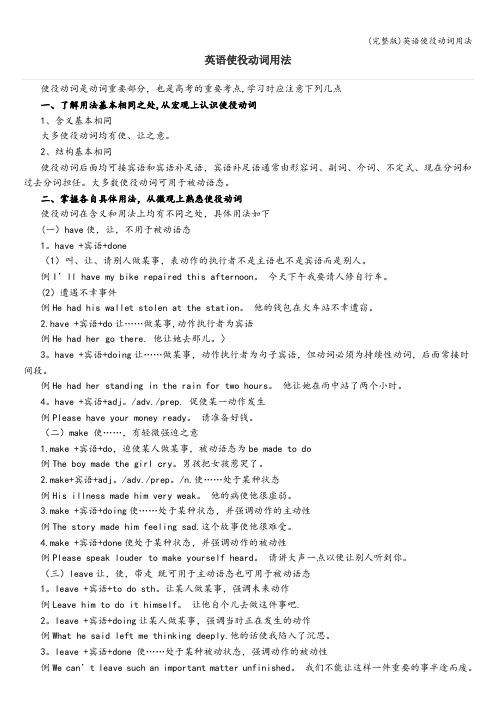
英语使役动词用法使役动词是动词重要部分,也是高考的重要考点,学习时应注意下列几点一、了解用法基本相同之处,从宏观上认识使役动词1、含义基本相同大多使役动词均有使、让之意。
2、结构基本相同使役动词后面均可接宾语和宾语补足语,宾语补足语通常由形容词、副词、介词、不定式、现在分词和过去分词担任。
大多数使役动词可用于被动语态。
二、掌握各自具体用法,从微观上熟悉使役动词使役动词在含义和用法上均有不同之处,具体用法如下(一)have使,让,不用于被动语态1。
have +宾语+done(1)叫、让、请别人做某事,表动作的执行者不是主语也不是宾语而是别人。
例I’ll have my bike repaired this afternoon。
今天下午我要请人修自行车。
(2)遭遇不幸事件例He had his wallet stolen at the station。
他的钱包在火车站不幸遭窃。
2.have +宾语+do让……做某事,动作执行者为宾语例He had her go there. 他让她去那儿。
〉3。
have +宾语+doing让……做某事,动作执行者为句子宾语,但动词必须为持续性动词,后面常接时间段。
例He had her standing in the rain for two hours。
他让她在雨中站了两个小时。
4。
have +宾语+adj。
/adv./prep. 促使某一动作发生例Please have your money ready。
请准备好钱。
(二)make 使……,有轻微强迫之意1.make +宾语+do,迫使某人做某事,被动语态为be made to do例The boy made the girl cry。
男孩把女孩惹哭了。
2.make+宾语+adj。
/adv./prep。
/n.使……处于某种状态例His illness made him very weak。
他的病使他很虚弱。
3.make +宾语+doing使……处于某种状态,并强调动作的主动性例The story made him feeling sad.这个故事使他很难受。
英语中使役动词的用法总结

英语中使役动词的用法总结英语中具有使役意义的动词较多,跟人们常常说的使役动词不是一个概念.通常我们说使役动词,指的是make, have, let这三个动词,它们在后接不定式作宾语补足语时要省去不定式符号to的特定用法.下面是英语中使役动词的用法总结,大家一起来看看吧!英语中使役动词的用法总结:1.have的用法1). have 宾语省to不定式:表示主语“要”“使”“让”宾语干某事,宾语和宾补之间是一种主动关系.而且还可以与情态动词will, would连用,不用于被动结构.The rich lady had the singer eat with his servants.I will have him come and help you.2). have 宾语现在分词:表示让某人或物连续进行某动作或处于某状态中,宾语和宾补是一种主动关系.亦可转化为“劝说,鼓励”宾语干某事.The two cheats had the lights burning all night long.He had us waiting for him three hours yesterday.I have them all talking to each other in English. 我鼓励他们用英语交谈.3). have 宾语过去分词:表示主语的主观意志,即主语让别人为自己完成某事,宾语和宾补是动宾关系.还可以表示主语遭受到来利或不测的事.Tom said he had had his TV set repaired.Tom had his wallet stolen on the bus yesterday.“别人”在句中一般不出现,这是它与结构1)的区别所在.试比较:Have you washed your clothes? 你洗了衣服了吗?(自己洗)Have you had your clothes washed? 你叫人洗了衣服了吗?(别人洗)4). have 宾语形容词/副词/介词短语作宾补Please have your tickets ready.The Emperor had nothing on.I am sure I’ll have him in the argument.2.let的用法1). let 宾语省to不定式:表示主语“要”“使”“让”宾语干某事,宾语和宾补之间是一种主动关系,罕用于被动语态.有时也可指一种假设.let后不能接现在分词,过去分词作宾补.Let them stay in the classroom and do their exercises themselves.Let AB be equal to CD. 假设AB等于CD.2). let 宾语副词/介词短语作宾补Let me in and let them out.Who let you into the building?3.make的用法1). make 宾语省to不定式:表示主语“要”“使”“让”宾语干某事,宾语和宾补之间是一种主动关系.此结构常用被动结构.make后不接现在分词作宾补.The teacher made the naughty boy stand there for an hour.The naughty boy was made to stand there for an hour.2).make 宾语过去分词,此结构中的宾语指人时常用到反身代词.He raised his voice to make himself heard.Can you easily make yourself understood in English?They will make an important plan known to the public soon.3). make 宾语形容词,宾语亦可是从句.The news made her happy.He made it clear that he objected to the proposal.三大使役动词make、have、get怎么区别:在英语学习中主要有三大使役动词——make、have和get。
所有使役动词的用法
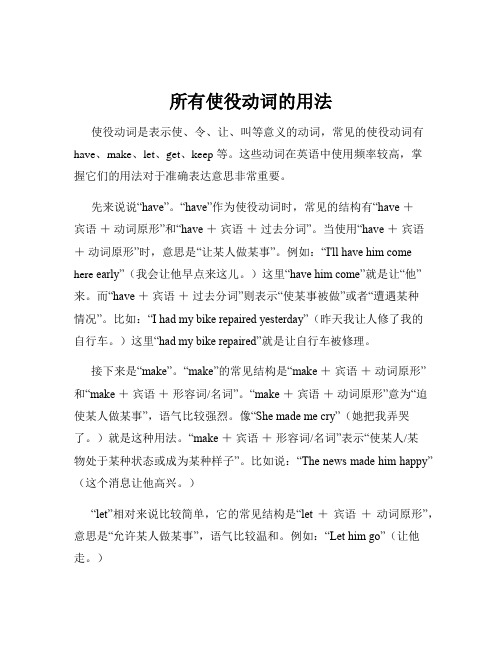
所有使役动词的用法使役动词是表示使、令、让、叫等意义的动词,常见的使役动词有have、make、let、get、keep 等。
这些动词在英语中使用频率较高,掌握它们的用法对于准确表达意思非常重要。
先来说说“have”。
“have”作为使役动词时,常见的结构有“have +宾语+动词原形”和“have +宾语+过去分词”。
当使用“have +宾语+动词原形”时,意思是“让某人做某事”。
例如:“I'll have him come here early”(我会让他早点来这儿。
)这里“have him come”就是让“他”来。
而“have +宾语+过去分词”则表示“使某事被做”或者“遭遇某种情况”。
比如:“I had my bike repaired yesterday”(昨天我让人修了我的自行车。
)这里“had my bike repaired”就是让自行车被修理。
接下来是“make”。
“make”的常见结构是“make +宾语+动词原形”和“make +宾语+形容词/名词”。
“make +宾语+动词原形”意为“迫使某人做某事”,语气比较强烈。
像“She made me cry”(她把我弄哭了。
)就是这种用法。
“make +宾语+形容词/名词”表示“使某人/某物处于某种状态或成为某种样子”。
比如说:“The news made him happy”(这个消息让他高兴。
)“let”相对来说比较简单,它的常见结构是“let +宾语+动词原形”,意思是“允许某人做某事”,语气比较温和。
例如:“Let him go”(让他走。
)“get”的用法稍微复杂一些。
“get +宾语+动词不定式”表示“说服某人做某事”。
例如:“I got him to help me”(我说服他帮助我。
)“get+宾语+现在分词”则表示“使某人/某物开始做某事”。
比如:“Canyou get the machine running?”(你能让这台机器运转起来吗?)“get +宾语+过去分词”意思是“使某事被做”,和“have +宾语+过去分词”的用法类似,但“get”更强调动作的执行者不是主语本身。
初中英语使役动词及其用法全汇总,仅此一份,必须收藏!

初中英语使役动词及其用法全汇总,仅此一份,必须收藏!英语中具有使役意义的动词较多,跟人们常常说的使役动词不是一个概念。
通常我们说使役动词,指的是make, have, let这三个动词,它们在后接不定式作宾语补足语时要省去不定式符号to。
但具有使役意义的动词数量上远不止这些,用法也较灵活,现将其分类叙述如下,以饷读者。
1使役动词have, let, make (常用于复合结构)1. have的用法1)have +宾语+do(省略to的不定式):表示主语“要”“使”“让”宾语干某事,宾语和宾补之间是一种主动关系。
The rich lady had the singer eat with her servants.这位富有的女士让这位歌手和她的仆人一起吃饭。
I will have him come and help you.我会让他来帮助你的。
2)have+宾语+现在分词:表示让某人或物连续进行某动作或处于某状态中,宾语和宾补是一种主动关系。
The two cheats had the lights burning all night long.这两个骗子让灯整晚亮着。
He had us waiting for him three hours yesterday.昨天他让我们一直等了他三个小时。
I have them all talking to each other in English.我鼓励他们用英语交谈。
3)have +宾语+过去分词:表示主语的主观意志,即主语让别人为自己完成某事,宾语和宾补是动宾关系,还可以表示主语遭受到来利或不测的事。
Tom said he had had his TV set repaired.汤姆修了他的电视机。
(别人修的)Tom had his wallet stolen on the bus yesterday.昨天汤姆使他的钱包被偷了。
(别人偷的)4)have+宾语+形容词/副词/介词短语作宾补Please have your tickets ready.请准备好你的票。
使役动词的用法
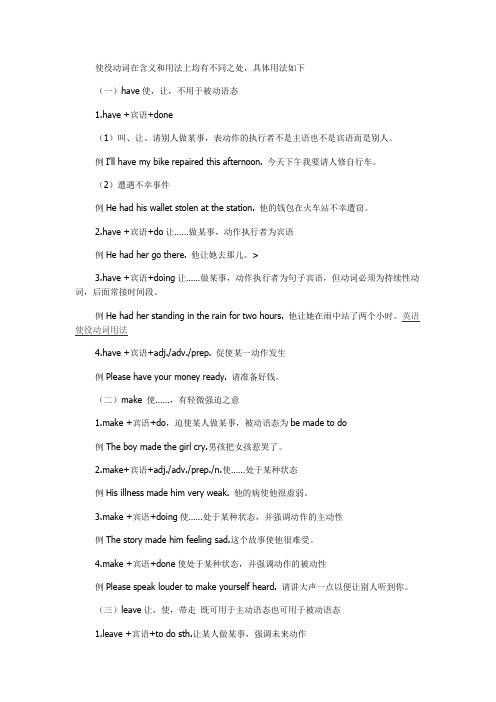
使役动词在含义和用法上均有不同之处,具体用法如下(一)have使,让,不用于被动语态1.have +宾语+done(1)叫、让、请别人做某事,表动作的执行者不是主语也不是宾语而是别人。
例I'll have my bike repaired this afternoon. 今天下午我要请人修自行车。
(2)遭遇不幸事件例He had his wallet stolen at the station. 他的钱包在火车站不幸遭窃。
2.have +宾语+do让……做某事,动作执行者为宾语例He had her go there. 他让她去那儿。
>3.have +宾语+doing让……做某事,动作执行者为句子宾语,但动词必须为持续性动词,后面常接时间段。
例He had her standing in the rain for two hours. 他让她在雨中站了两个小时。
英语使役动词用法4.have +宾语+adj./adv./prep. 促使某一动作发生例Please have your money ready. 请准备好钱。
(二)make 使……,有轻微强迫之意1.make +宾语+do,迫使某人做某事,被动语态为be made to do例The boy made the girl cry.男孩把女孩惹哭了。
2.make+宾语+adj./adv./prep./n.使……处于某种状态例His illness made him very weak. 他的病使他很虚弱。
3.make +宾语+doing使……处于某种状态,并强调动作的主动性例The story made him feeling sad.这个故事使他很难受。
4.make +宾语+done使处于某种状态,并强调动作的被动性例Please speak louder to make yourself heard. 请讲大声一点以便让别人听到你。
使役动词知识点总结

使役动词知识点总结一、使役动词的基本用法1.1 使役动词的基本功能是通过对宾语的动作实施控制,使其发生某种动作或者状态。
比如:- She made him clean the room.(她让他打扫房间)- He had her sing a song.(他让她唱首歌)- They got him to confess.(他们促使他招供)1.2 有时候,使役动词的宾语可以是动词不定式,表示被控制的动作或者状态。
比如:- She made him study hard.(她让他用功学习)- They had her do the dishes.(他们让她洗碗)- The teacher got the students to listen to his lecture.(老师让学生们听他的讲座)1.3 使役动词也可以接双宾语,表示被控制的人和动作的对象。
比如:- She made him a cake.(她给他做了一个蛋糕)- They had their car repaired.(他们让修了他们的汽车)- The boss got his employees new uniforms.(老板让员工们换了新的制服)二、常见的使役动词和它们的语法结构2.1 make“make”是最常见的使役动词之一,其语法结构比较简单,后面可以接宾语和动词原形或者动词不定式。
比如:- make + 宾语 + 动词原形She made him clean the room.(她让他打扫房间)- make + 宾语 + 动词不定式She made him study hard.(她让他用功学习)2.2 have“have”也是常见的使役动词,其语法结构与“make”类似,后面同样可以接宾语和动词原形或者动词不定式。
比如:- have + 宾语 + 动词原形He had her sing a song.(他让她唱首歌)- have + 宾语 + 动词不定式They had her do the dishes.(他们让她洗碗)2.3 get“get”同样可以表示使役的意思,其语法结构也和“make”、“have”类似。
初中英语使役动词及其用法全汇总,仅此一份,必须收藏!

1使役动词have,let,make(常用于复合结构)1.have的用法1)have+宾语+d。
(省略to的不定式):表示主语“要”“使”“让”宾语干某事,宾语和宾补之间是一种主动关系。
The rich lady had the singer eat with her servants.这位富有的女士让这位歌手和她的仆人一起吃饭。
I will have him come and help you.我会让他来帮助你的。
2)have+宾语+现在分词:表示让某人或物连续进行某动作或处于某状态中,宾语和宾补是一种主动关系。
The two cheats had the lights burning all night long,这两个骗子让灯整晚亮着。
He had us waiting for him three hours yesterday.昨天他让我们一直等了他三个小时。
I have them all talking to each other in English,我鼓励他们用英语交谈。
3)have+宾语+过去分词:表示主语的主观意志,即主语让别人为自己完成某事,宾语和宾补是动宾关系,还可以表示主语遭受到来利或不测的事。
Tom said he had had his TV set repaired.汤姆修了他的电视机。
(别人修的)Tom had his wallet stolen on the bus yesterday.昨天汤姆使他的钱包被偷了。
(别人偷的)4)have+宾语+形容词/副词/介词短语作宾补Please have your tickets ready,请准备好你的票。
The Emperor had nothing on.这位皇帝什么都没在做。
I am sure I'11have him in the argument.2.let的用法1)let+宾语+d。
(省to不定式):表示主语“要”“使”“让”宾语干某事,宾语和宾补之间是一种主动关系。
英语中的使役动词的用法
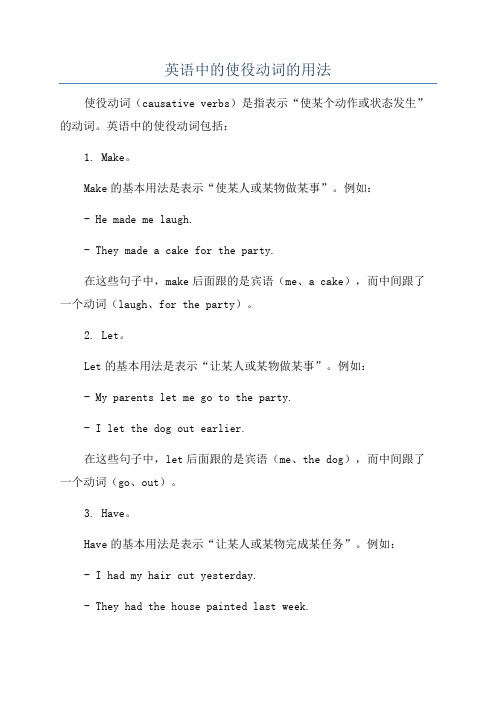
英语中的使役动词的用法使役动词(causative verbs)是指表示“使某个动作或状态发生”的动词。
英语中的使役动词包括:1. Make。
Make的基本用法是表示“使某人或某物做某事”。
例如:- He made me laugh.- They made a cake for the party.在这些句子中,make后面跟的是宾语(me、a cake),而中间跟了一个动词(laugh、for the party)。
2. Let。
Let的基本用法是表示“让某人或某物做某事”。
例如:- My parents let me go to the party.- I let the dog out earlier.在这些句子中,let后面跟的是宾语(me、the dog),而中间跟了一个动词(go、out)。
3. Have。
Have的基本用法是表示“让某人或某物完成某任务”。
例如:- I had my hair cut yesterday.- They had the house painted last week.在这些句子中,have后面跟的是宾语(my hair、the house),而后面的动词(cut、painted)则是被动形式。
- I had my hair cut yesterday. (主动语态)。
- My hair was cut yesterday. (被动语态)。
总结来说,使役动词的用法主要包括:make表示直接的“强制”,let表示间接的“允许”,have表示交给他人去完成某事。
如果需要表达被动语态,可以使用have + 过去分词的结构。
中考英语使役动词及其用法全汇总
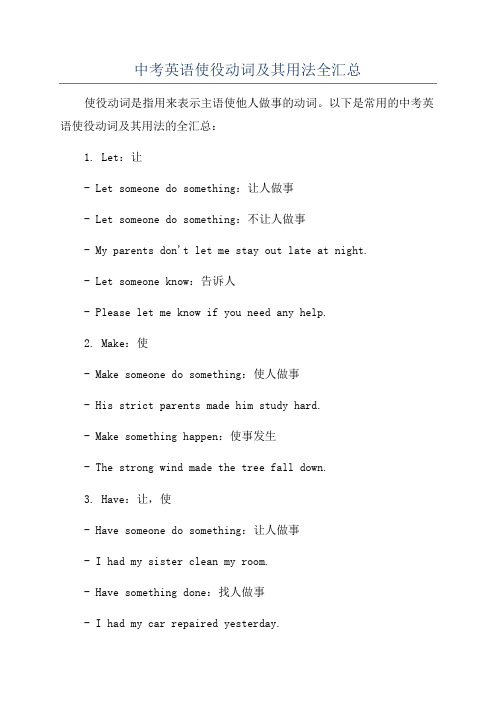
中考英语使役动词及其用法全汇总使役动词是指用来表示主语使他人做事的动词。
以下是常用的中考英语使役动词及其用法的全汇总:1. Let:让- Let someone do something:让人做事- Let someone do something:不让人做事- My parents don't let me stay out late at night.- Let someone know:告诉人- Please let me know if you need any help.2. Make:使- Make someone do something:使人做事- His strict parents made him study hard.- Make something happen:使事发生- The strong wind made the tree fall down.3. Have:让,使- Have someone do something:让人做事- I had my sister clean my room.- Have something done:找人做事- I had my car repaired yesterday.4. Get:让,使- Get someone to do something:让人做事- Get something done:找人做事- I need to get my hair cut.5. Help:帮助- Help someone do something:帮助人做事- Can you help me open the door?- Help someone with something:帮助人做事- I need help with my homework.6. Ask:请求,要求- Ask someone to do something:请求人做事- I asked my teacher to explain the problem to me.。
完整版)使役动词的用法
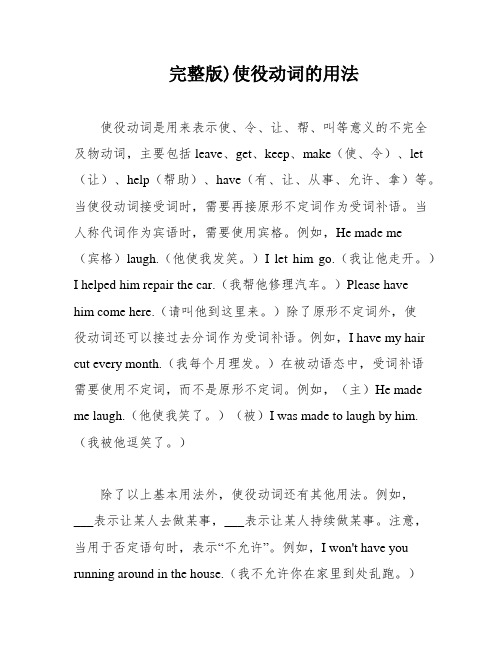
完整版)使役动词的用法使役动词是用来表示使、令、让、帮、叫等意义的不完全及物动词,主要包括leave、get、keep、make(使、令)、let (让)、help(帮助)、have(有、让、从事、允许、拿)等。
当使役动词接受词时,需要再接原形不定词作为受词补语。
当人称代词作为宾语时,需要使用宾格。
例如,He made me(宾格)laugh.(他使我发笑。
)I let him go.(我让他走开。
)I helped him repair the car.(我帮他修理汽车。
)Please havehim come here.(请叫他到这里来。
)除了原形不定词外,使役动词还可以接过去分词作为受词补语。
例如,I have my hair cut every month.(我每个月理发。
)在被动语态中,受词补语需要使用不定词,而不是原形不定词。
例如,(主)He made me laugh.(他使我笑了。
)(被)I was made to laugh by him.(我被他逗笑了。
)除了以上基本用法外,使役动词还有其他用法。
例如,___表示让某人去做某事,___表示让某人持续做某事。
注意,当用于否定语句时,表示“不允许”。
例如,I won't have you running around in the house.(我不允许你在家里到处乱跑。
)在使用使役动词时,需要注意以下几点。
首先,have sb do表示让某人干某事,___表示让某人或某事处于某种状态,听任,___表示让别人干某事,遭受到。
其次,done这个动作不是主语发出来的。
其次,make sb do表示让某人干某事。
They made me repeat the story。
It was a frustrating experience。
but I had no choice but to comply with their demand.What makes the grass grow。
6大使役动词的用法

6大使役动词的用法have使,让,不用于被动语态,have +宾语+done。
make 使……,有轻微强迫之意,make +宾语+do。
leave让,使,带走,既可用于主动语态也可用于被动语态。
get使,让,get +宾语+to do。
keep使,让,保持。
let使,让,let +宾语+do。
(一)have使,让,不用于被动语态1.have +宾语+done(1)叫、让、请别人做某事,表动作的执行者不是主语也不是宾语而是别人。
例I'll have my bike repaired this afternoon. 今天下午我要请人修自行车。
(2)遭遇不幸事件例He had his wallet stolen at the station. 他的钱包在火车站不幸遭窃。
2.have +宾语+do让……做某事,动作执行者为宾语例He had her go there. 他让她去那儿。
>3.have +宾语+doing让……做某事,动作执行者为句子宾语,但动词必须为持续性动词,后面常接时间段。
例He had her standing in the rain for two hours. 他让她在雨中站了两个小时。
英语使役动词用法4.have +宾语+adj./adv./Pp. 促使某一动作发生例Please have your money ready. 请准备好钱。
(二)make 使……,有轻微强迫之意1.make +宾语+do,迫使某人做某事,被动语态为be made to do例The boy made the girl cry.男孩把女孩惹哭了。
2.make+宾语+adj./adv./Pp./n.使……处于某种状态例His illness made him very weak. 他的病使他很虚弱。
3.make +宾语+doing使……处于某种状态,并强调动作的主动性例The story made him feeling sad.这个故事使他很难受。
关于英语语法中使役动词的用法详细分析

关于英语语法中使役动词的用法详细分析使役动词在英语语法中是属于一个比较难的知识点,但如果你能够在英语写作中用上它的话,会让你的作文增分不少,今天就让我们来好好学习一下吧。
使役意义状态动词get, leave, set, send, keep, drive, etc.常用于复合结构中)1. get:使成为/变得某种状态或结果。
I can’t get the old radio to work.我无法让那旧收音机工作起来。
(接带to不定式作宾补)Can you really get that old car going again?你真能让那旧车运转起来吗?The farmer got his planting done before the rain came.那农民在雨季前完成了种植。
He got his wrist broken.他折断了手腕。
(主语发生了不幸的事)She soon got the children ready for school.她迅速使孩子们做好了上学准备。
2. leave:使保持/处于某种状态Leave your hat and coat in the hall.把帽子和外套放在大厅里。
Did you leave the doors and windows firmly fastened?你把门窗紧紧锁上了吗?Always leave things where you can find them again.总应把东西放在能再次找到的地方。
Who left that window open?谁让窗户开着?Don’t leave him waiting outside in the rain.别让他在外面雨中等待。
Leave somebody / something alone.不要干涉某人或某事。
3. set:使某人或某物处于或达到某种特殊的状态或关系set somebody at his ease 使某人安逸/舒适/心情放松set something in order 使某物井然有序set somebody free / at liberty 使某人获得自由,释放(犯人等)It’s time we set the machine going. 是我们发动机器的时候了。
使役动词用法汇总

使役动词用法汇总使役动词是表示使、令、让、帮、叫等意义的动词,常见的使役动词有make、let、have等。
以下是使役动词的用法汇总:1. make意为“做;制造;组装;写;生产”。
例如:Please make a cake for your little brother.2. let意为“允许;让”。
例如:Let me show you how to use this machine.3. have意为“使;让”。
例如:I have my hair cut every three months.4. get意为“使;叫;让”。
例如:I'll get the doctor.5. leave意为“让;使”。
例如:I left him alone in the room.6. drive意为“驾驶;驱赶”。
例如:The car won't start. I think someone is trying to steal it. Let me drive it away.7. send意为“派;发送”。
例如:Send the letter by airmail.8. tell意为“告诉;讲述”。
例如:He told me the news.9. order意为“命令;点(菜)”。
例如:He ordered a pizza for lunch.10. arrive意为“到达;抵达”。
例如:I arrived in Beijing at 10 o'clock yesterday morning.11. allow意为“允许;准许”。
例如:The doctor won't allow him to go to work.12. permit意为“允许;许可”。
例如:The government doesn't permit the use of chemical weapons.13. support意为“支持;帮助”。
英语中的使役动词及用法
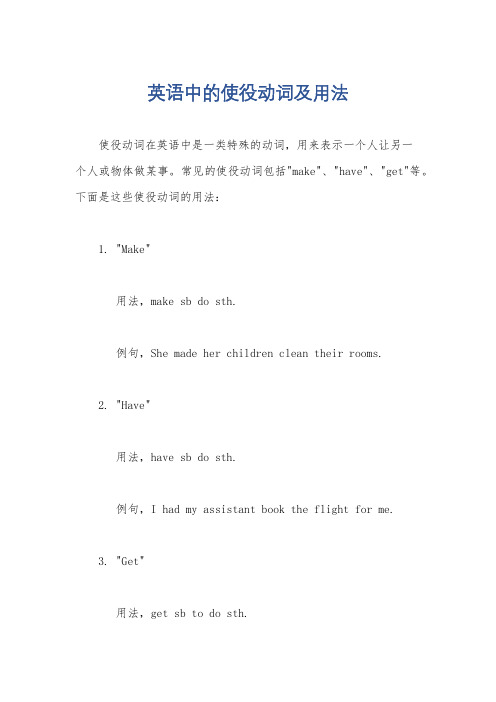
英语中的使役动词及用法
使役动词在英语中是一类特殊的动词,用来表示一个人让另一
个人或物体做某事。
常见的使役动词包括"make"、"have"、"get"等。
下面是这些使役动词的用法:
1. "Make"
用法,make sb do sth.
例句,She made her children clean their rooms.
2. "Have"
用法,have sb do sth.
例句,I had my assistant book the flight for me.
3. "Get"
用法,get sb to do sth.
例句,I got my brother to help me with my homework.
这些使役动词在句子中通常用于将一个人或物体置于动作的接受者位置,从而使其执行某项行为。
这些动词的用法在日常英语交流中非常常见,对于学习英语的人来说是非常重要的。
通过掌握这些使役动词的用法,我们可以更准确地表达自己的意思,使交流更加清晰和有效。
- 1、下载文档前请自行甄别文档内容的完整性,平台不提供额外的编辑、内容补充、找答案等附加服务。
- 2、"仅部分预览"的文档,不可在线预览部分如存在完整性等问题,可反馈申请退款(可完整预览的文档不适用该条件!)。
- 3、如文档侵犯您的权益,请联系客服反馈,我们会尽快为您处理(人工客服工作时间:9:00-18:30)。
使役动词1. 使役动词是表示使、令、让、帮、叫等意义的不完全及物动词, 主要有leave.get.keep.make(使, 令), let(让), help(帮助), have(有;让;从事;允许;拿)等。
2. 使役动词后接受词, 再接原形不定词作受词补语。
接宾语时,人称代词用宾格。
He made me(宾格)laugh.他使我发笑。
I let him go.我让他走开。
I helped him repair the car.我帮他修理汽车。
Please have him come here.请叫他到这里来。
3. 使役动词还可以接过去分词作受词补语。
I have my hair cut every month.我每个月理发。
4. 使役动词的被动语态的受词补语用不定词, 不用原形不定词。
(主)He made me laugh.他使我笑了。
(被)I was made to laugh by him.我被他逗笑了。
使役动词有以下用法:a. have somebody do sth 让某人去做某事I had him arrange for a car.b. have somebody doing sth. 让某人持续做某事。
He had us laughing all through lunch.注意:用于否定名时,表示“允许”i won't have you running around in the house. 我不允许你在家里到处乱跑。
小议“使役动词”的用法1. have sb do 让某人干某事e.g:What would you have me do?have sb/sth doing 让某人或某事处于某种状态,听任e.g: I won't have women working in our company.The two cheats had the light burning all night long.have sth done 让别人干某事,遭受到e.g:you 'd better have your teeth pulled out.He had his pocket picked.notes: "done" 这个动作不是主语发出来的。
2. make sb do sth 让某人干某事e.g:They made me repeat the story.What makes the grass grow?notes: I was made to repeat the story.make sb/sth done/adj./ne.g. The news made him happy.He couldn't make himself heard above the noise of the traffic.His actions made him universally respected.He made her his wife.3. get sb to do 使某人干某事e.g: I can't get anyone to do the work properly. get sth done 让别人干某事e.g: I must get my hair cut. Can you get the work finished in time? 4.leave sb to do sth 让某人干某事e.g: We left him to paint the gate. I'll leave you to settle all the business. leave sb doing 让继续处于某种状态 e.g: Don't leave her waiting outside in the rain. We left him painting the gate.leave sth done/adj./prep.phrase e.g:Please excuse me if I have left any of your questions unanswered. His illness has left him weak.I was left with a ray of hope.使役性动词(Causative Verb )1. make /have/ let +sb +do sth.2. get/set/leave + sb to do/doing sth.不完全及物动词不完全及物动词1. 不完全及物动词是除要有受词外, 还需要受词补语以补足其意义的及物动词。
【参见与格动词, 完全及物动词】2. 由不完全及物动词构成的句型一般为: 主词+不完全及物动词+受词+受词补语。
His mother named him Tommy.他母亲叫他汤米。
Tommy是受词补语,若没有这个字,这句话的意思就不完整,因此named是不完全及物动词。
不完全不及物动词其实就是联系动词,虽有意义,但不完全,需要加名词、形容词、代名词等作主词补语以补足其意义。
联系动词按其含义可以分为二类。
类型1: 表示状态和状态的持续,如:be(是),seem(似乎),look(看起来),即pear(似乎),feel(觉得),sound(听起来), smell(闻起来), taste(尝起来), keep(保持), remain(保持), stand(站立), lie (躺), stay(停留)等。
类型2:表示从一种状态转变为另一种状态,如:become(变成),go(变得),get(变得),turn(变成),grow(变成),fall(变成某种状态), come(成为), run(变成)等。
值得注意的是:联系动词没有被动式。
及物动词和不及物动词的用法比较1)及物动词后面必须跟宾语意义才完整的实义动词,叫做及物动词(transitive verb)。
如:I believe that the committee will consider our suggestion. 我相信委员会将会考虑我们的建议。
“ How long can I keep the book ? ” Harry asked. 哈里问:“这本书我可以借多久? ”Dr. Bethune set us a good example. 白求恩大夫给我们树立了好榜样。
Crude oil contains many useful substances. 原油含有许多有用的物质。
2)不及物动词本身意义完整后面不须跟宾语的实义动词,叫做不及物动词(intransitive verb)。
如:Birds fly. 鸟会飞。
It happened in June 1932. 这件事发生于一九三;年六月。
My watch stopped. 我的表停了。
She spoke at the meeting yesterday evening. 她在昨天晚上的会上发了言。
3)兼作及物动词和不及物动词英语里有不少实义动词可以兼作及物动词和不及物动词。
这样的动词又有两种不同的情况:a)兼作及物动词和不及物动词时,意义不变。
试比较:Shall I begin at once? 我可以立刻开始吗?(begin 作不及物动词)She began working as a librarian after she left school. 她毕业后当图书馆管理员。
(began 作及物动词)When did they leave Chicago? 他们是什么时候离开芝加哥的?(leave 作及物动词)They left last week. 他们是上周离开的。
(left 作不及物动词)b)兼作及物动词和不及物动词时,有时意义不尽相同。
如:Wash your hands before meals. 饭前要洗手。
Does this cloth wash well? 这布经得起洗吗?4)与汉语的比较有时英语动词的及物和不及物的用法,与汉语的用法不一样,请注意下列两种情况:a)有的动词在英语里只能用作不及物动词,而汉语则可用作及物动词,如arrive 到达,agree 同意,1isten 听。
英语里这些动词后面常接介词。
如:We arrived at the railway station at noon. 我们于中午到达火车站。
(at 不能省去)(比较:We reached the railway station at noon.)Everybody listened to the lecture with great interest. 每个人都很有兴趣地听讲课。
(to 不可省去)(比较:We all heard the lecture.)Do they agree to the plan? 他们同意这个计划吗?(to 不可省去)b)有的动词在英语里能用作及物动词,而在汉语里则不能用作及物动词,如serve为…服务。
Our children are taught to serve the people wholeheartedly. 我们的儿童被教以全心全意为人民服务(一)have使,让,不用于被动语态O l.have + 宾语+done(1)叫、让、请,致使别人做某事,动作的执行者不是主语也不是宾语而是别人。
(强调主观的意志,即主语的意志致使某事发生或被做到)— I ' ll have my bike repaired this afternoon. 今天下午我要请人修自行车。
— I have my hair cut every month.我每个月都理发。
表示主观意志的 have 也可以用 get 代替,例如:— Where can I get (have )this printed ?我在哪里能 (找人)把这份东西打印出来呢? (2) 遭遇不幸事件(与主观意志完全无关) — He had his wallet stolen at the station.他的钱包在火车站不幸遭窃。
— He has his leg broken in a fall .他的腿摔断了。
2. ............................................ have +宾语+do 让 做某事,动作执行者为宾语 — He had her go there. 他让她去那儿。
— I have my children clean the house before you arrive .在你们来之前,我让孩子们把屋子打扫干净了。
